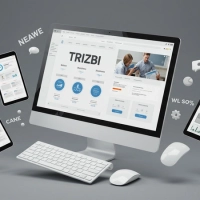
Can you manage the payments and receivables in your company in a healthy way? Especially for B2B businesses, keeping cash flow under control is one of the most critical steps in financial sustainability. This is where the question “what is current payment?” comes to the fore. Current payment is a process in which customer and supplier account transactions are regularly recorded and tracked. This process ensures that payments are made on time, receivables are collected, and financial balance is maintained.
So, why is current payment tracking so important? Because tracking done with manual methods can lead to both loss of time and risk of error. Fortunately, ERP systems and B2B management software offer great convenience to businesses by automating this process. In this article, we will detail the concept of current payment and explain step by step how you can create an effective tracking system with ERP-based solutions.
If you're ready to increase your financial efficiency, let's get started.
What is Current Payment?

Current payment is a financial process in which the receivables and payables of businesses with their customers and suppliers are regularly recorded, monitored and managed. The definition of current payment is briefly one of the basic parts of the accounting system that ensures transparent and planned control of cash flow.
This process is critical for companies in terms of maintaining their “current account” balance. Making payments on time, monitoring receivables and minimizing financial risks are essential for the sustainability of businesses. In addition, healthy supplier relationships and cash flow management also depend on current payment management.
Let's explain with a simple example:
- A manufacturing company makes a 30-day payment commitment to its supplier for materials.
- This payment is recorded as a “debit” in the current account records and is tracked until the due date.
When the payment is made, it is automatically updated in the system and integrated into financial reports thanks to the current payment tracking.
What are the Current Payment Types?

Businesses can use different current payment methods when managing their financial transactions. Each method has its own advantages and usage scenarios. Here are the most common current payment types:
Cash Payments
Cash payment is a form of payment that is made instantly with physical money. This method is often preferred, especially in small businesses or urgent payments. Its advantage is that the transaction is fast and without an intermediary. However, cash tracking can be difficult and can pose a security risk.
Example Usage: A café might pay its supplier in cash for a daily purchase of vegetables.
Bank Transfer
A bank transfer is an electronic transfer of money between accounts. This method provides transparent records for current payment tracking and is widely used in B2B transactions. Its advantages include reliability and traceability. Its disadvantages are transaction fees or sometimes delays.
Example of Usage: A manufacturing company pays the invoice amount to its supplier via EFT and integrates the record into the automatic system.
Payment by Check and Promissory Note
Checks and promissory notes are physical documents used in deferred payments. They provide flexibility, especially in supplier relationships. The advantage is that it helps financial planning by postponing cash flow. The disadvantage is the risk of the check bouncing or the need for manual current payment tracking.
Example Usage: A construction company defers payment to its materials supplier by issuing a 60-day check.
Payment by Credit Card
Payment by credit card is a modern method used in installment or one-time transactions. Its advantage is the fast payment and ease of registration provided by card payment systems. However, transaction commissions and the risk of debt accumulation in excessive use are its disadvantages.
Example Use: A retail store pays a supplier with a corporate credit card for an urgent purchase of office supplies.
Current payment methods can be combined flexibly according to the needs of businesses. The right choice provides financial efficiency and ease of current payment tracking.
Why Should Current Payments Be Tracked?

Monitoring current payments is a critical step in maintaining the financial health of businesses and ensuring sustainable growth. Regular monitoring of payments helps keep cash flow under control and prevent financial risks. So why is this monitoring so important? Here are the main reasons:
- Regulating cash flow: Keeping track of current payments on time prevents liquidity problems by maintaining the balance between income and expenses.
- Maintaining the Debt/Credit balance: Unpaid debts or uncollected receivables can create a deficit in the financial statements. Regular monitoring ensures that this balance is managed transparently.
- Strengthening customer/supplier relationships: Timely payments help build long-term relationships with customers while increasing supplier trust.
- Prevent delays: Overdue payments can lead to additional interest costs or legal issues. The tracking system minimizes these risks.
Tracking current payments can be complicated by manual processes, but digital solutions like B2B management software or ERP systems automate this process, reducing error rates and saving time.
How to Track Current Payments with Trizbi ERP?
Trizbi ERP is a user-friendly B2B management software that integrates the financial processes of businesses on a single platform. It offers operational efficiency by facilitating transactions such as current payment tracking, inventory management and reporting. Here are the current payment tracking steps with Trizbi ERP:
- Creating a Current Account
- Log in to the Trizbi ERP panel and click on the “Current Accounts” module.
- Press the “Add New Account” button and enter customer or supplier information (title, contact, tax number).
- Save the account. You can now track all payments and collections for this current account.
- (Note: The image of the “Creating a Current Account” page can be used to add a screenshot.)
- Payment Adding Process
- Select the relevant customer or supplier from the current account list.
- Click on “Add Payment” and enter the payment amount, due date, description and payment method (cash, EFT, check).
- Complete the transaction with the "Save" button. The system will automatically reflect this payment in the reports.
- Tip: You can activate the “Automatic Reminder” feature for recurring payments.
- Reporting and Tracking
- Select “Current Payment Reports” from the “Reports” menu.
- Customize with date range, payment status (completed/pending), or current account filter.
- Simplify your financial analysis by downloading daily or weekly reports in PDF/Excel format.
With Trizbi ERP, current tracking centralizes all your financial movements and works integrated with the stock management system and purchasing processes. In this way, you can optimize your payment plans according to your stock movements.
In summary: ERP software automates payment recording processes, saving you time and giving you financial control.
Common Mistakes Made in Current Payment Tracking

Do you track your payments with Excel spreadsheets or paper records? These methods can lead to critical errors in the current payment tracking process. Here are the most common problems and suggested solutions:
- Keeping track manually: Excel or physical records cause data entry errors and waste time.
- Solution: Use an automation-focused B2B management program. Trizbi ERP automatically records all payments, reducing the risk of errors to zero.
- Not reporting: Irregular reporting makes cash flow invisible and financial planning difficult.
- Solution: Track your income-expense balance on a single screen with Trizbi ERP's instant reporting module.
- Forgetting to update: Late entry of payments into the system leads to inconsistencies between the records and the actual data.
- Solution: Trizbi ERP automatically updates payments, eliminating the risk of “forgetting”.
- Skipping payment dates: Failure to follow due dates can result in late payments penalties or loss of supplier trust.
- Solution: Trizbi ERP's “Automatic Reminder” feature sends notifications to you and the relevant units regarding payment dates.
These errors in the current payment tracking process can be easily prevented with ERP software. Trizbi combines all your financial transactions in a central system and gives you control.
Result: Solid Financial Structure with Correct Tracking

Current payment tracking is a fundamental process for businesses to regulate cash flow, maintain a balance between payables and receivables, and ensure financial transparency. Proper tracking not only controls costs, but also strengthens customer and supplier relationships.
Trizbi ERP minimizes errors and saves you time by fully automating this process. Thanks to its modules that work integrated with the stock management system, you can plan your payments in sync with your stock movements.
“Easily manage your current payment process with Trizbi ERP. Create a free demo request now and take financial control!”























